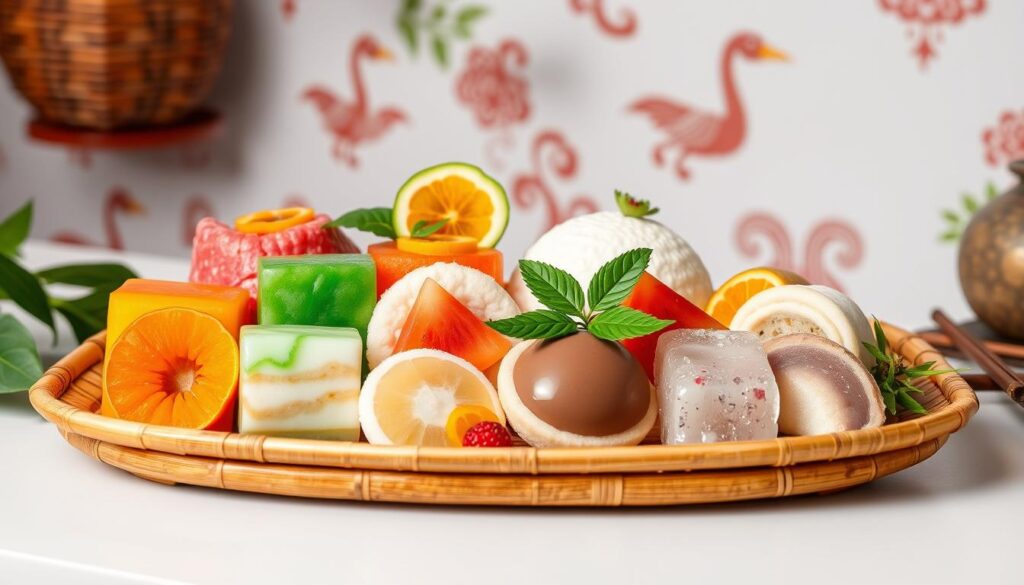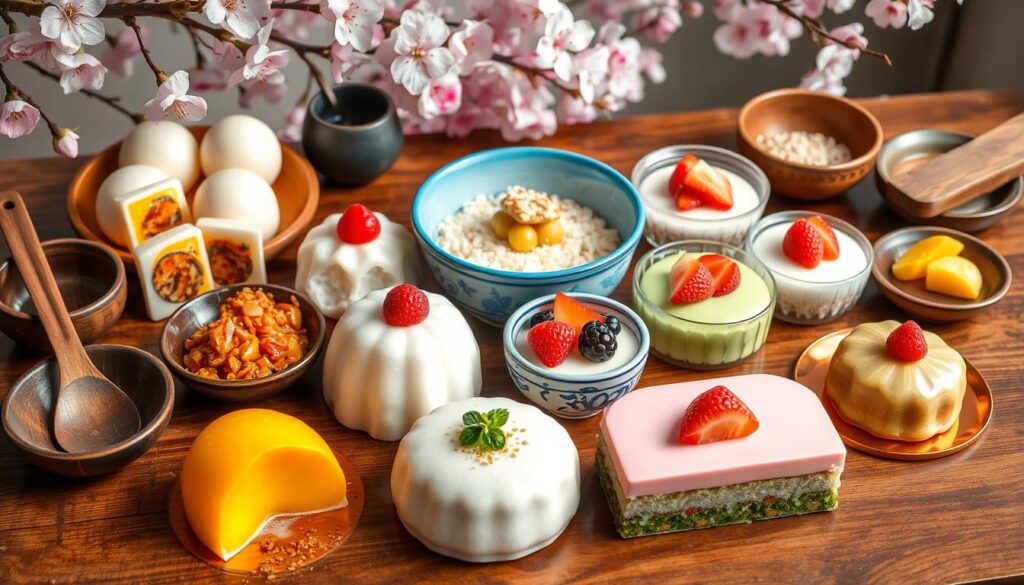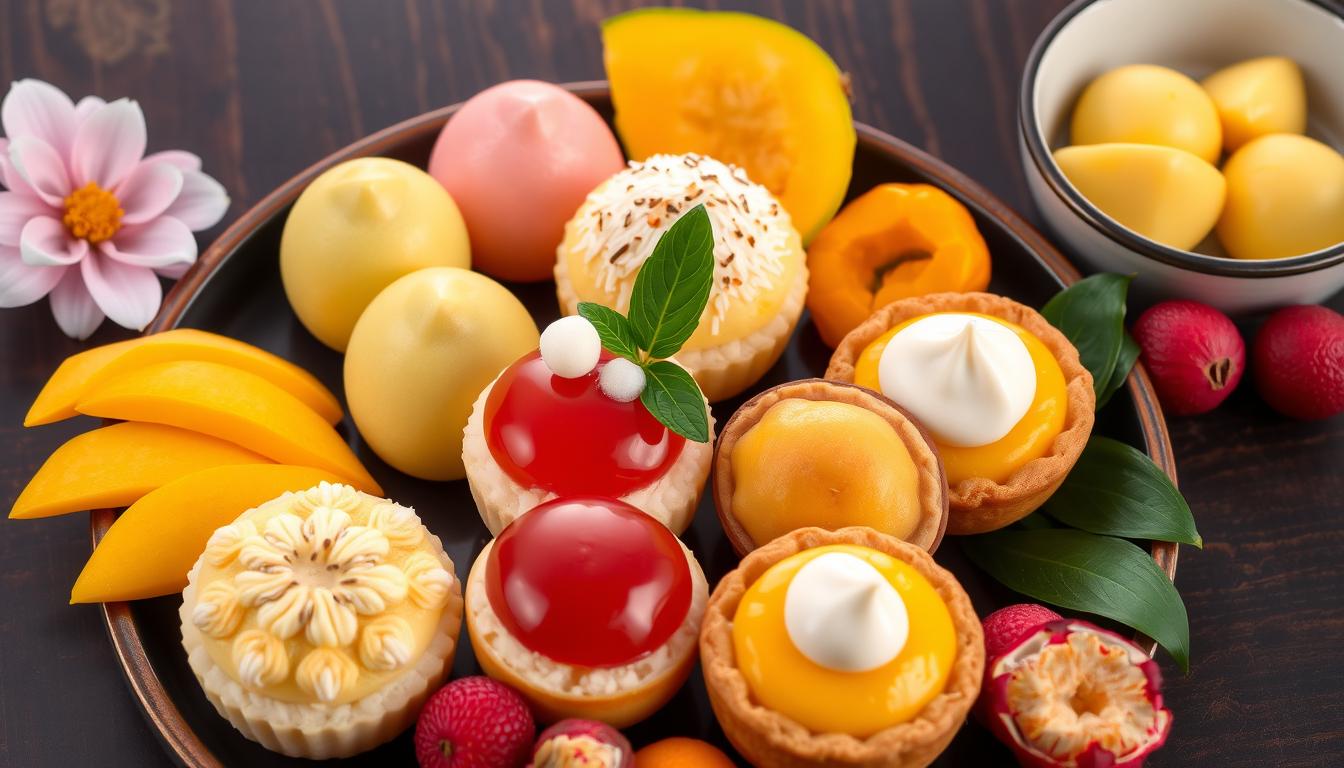Imagine diving into a world of sweet treats, where Asian desserts bring a unique flavor to your taste buds. You’ll find 18 easy Asian desserts, 8 Asian-inspired ones, and 7 popular ones. This variety takes you on a journey from Japan’s delicate mochi to India’s vibrant sweets.
Exploring Asian desserts, you’ll see many easy recipes to try at home. You’ll taste the diversity of Asian cuisines and their rich history. Whether you prefer traditional or modern, there’s something for everyone. You’ll find desserts with traditional ingredients like matcha, ube, and red bean paste.
Table of Contents
Key Takeaways
- Asian desserts offer a unique and flavorful twist to satisfy your sweet tooth
- There are 18 easy asian desserts, 8 asian-inspired desserts, and 7 popular asian desserts to choose from
- Asian desserts cater to all tastes and preferences, with a diverse range of options available
- Easy asian desserts are highly represented, making it simple to try new recipes at home
- Asian desserts incorporate traditional ingredients like matcha, ube, and red bean paste
- Asian desserts are a delightful escape for the senses, with a rich culinary heritage and diverse range of options
Understanding the Art of Asian Desserts
Exploring Asian desserts reveals a rich cultural heritage and a love for sweets. Desserts hold great importance in Asian culture, often served at special events. They symbolize hospitality and respect. With easy Asian recipes, you can make delicious desserts using common and specialty ingredients.
Popular desserts include mango pudding, mochi, and coconut-based treats. These are known for their creaminess and refreshing flavors. You can also try making traditional sweets like sesame balls and glutinous rice balls. For a modern touch, try bingsu or ji de chi, a dessert chain in Singapore.
To make these desserts, you’ll need ingredients like rice, coconut milk, and red bean paste. You can also experiment with new flavors and ingredients. Whether you’re looking for easy recipes or new desserts, Asian sweets offer a wide range. Their rich cultural heritage and delicious flavors make them popular worldwide.
| Dessert | Ingredients | Origin |
|---|---|---|
| Mango Pudding | Mango, sugar, cream | Asia |
| Mochi | Rice flour, water, sugar | Japan |
| Coconut Dessert | Coconut milk, sugar, cream | Asia |
Exploring Asian desserts opens up a world of delicious and unique sweets. With easy recipes and common ingredients, you can make your own Asian-inspired desserts. Whether you prefer traditional sweets or modern twists, there’s something for everyone.
Must-Try Japanese Sweet Treats
Exploring japanese desserts opens a door to a world of unique flavors. Mochi, a traditional Japanese rice cake, is a key ingredient in many desserts. It’s especially loved during the New Year (Oshogatsu) and Cherry Blossom Viewing (Hanami) seasons.
Daifukumochi, or daifuku, is a favorite with red bean paste or other fillings. Yokan, a wagashi made with agar, often has red bean paste, chestnuts, and more. Dango, made from uruchi and glutinous rice flour, is a popular street food in Japan.
Other must-try japanese desserts include:
- Daigaku imo, a Japanese dessert made with candied sweet potatoes
- Imagawayaki, anko-filled Japanese sweets traditionally cooked in disk-shaped cast iron molds
- Monaka, a traditional Japanese dessert made with sweet red bean paste sandwiched between mochi wafers
- Taiyaki, a fish-shaped pastry filled with sweet red bean paste
These desserts highlight the delicate flavors and textures of Japanese sweets. They often use seasonal ingredients, showing Japan’s love for nature and the changing seasons.
Essential Korean Dessert Delicacies
Korean desserts are known worldwide for their unique tastes and ingredients. You can find both traditional and modern desserts in Korea. These range from sweet rice cakes to modern patbingsu, making them a must-try.
Hotteok is a sweet pancake filled with honey and cinnamon. Bungeo-ppang is a fish-shaped pastry with sweet red bean paste. These desserts are tasty and look great, perfect for enjoying while exploring Korea.
Korean desserts often use traditional ingredients like sweet red bean paste, matcha, and sweet potato. These are found in desserts like shaved ice, ice cream, and lattes. You can also try modern twists, like mint chocolate and sweetcorn flavors.
Traditional Korean Sweet Flavors
Traditional Korean desserts are known for their sweet tastes. Honey, sugar, and fruit are common ingredients. You can find desserts like injeolmi, a sweet rice cake, and yakgwa, a deep-fried cookie.
Popular Street Food Desserts
Korean street food desserts are a must-try. Favorites include hotteok, bungeo-ppang, and patbingsu. They’re tasty, affordable, and easy to eat on the go.
Modern Korean Dessert Trends
Modern Korean desserts offer unique and delicious flavors. You can find desserts like matcha and sweet potato, as well as mint chocolate and sweetcorn. These can be found at cafes and bakeries across Korea, showcasing the country’s modern dessert culture.
Vibrant Vietnamese Desserts
Exploring Vietnamese desserts reveals a mix of old and new tastes. They often use fresh fruits, coconut milk, and tapioca pearls. This reflects Vietnam’s tropical weather and rich farming land. Tropical fruits like mango, lychee, dragon fruit, and banana are common in these desserts. They make sweet and cool treats.
Chè is a sweet soup with beans, tubers, and fruits. Banh flan is a creamy caramel dessert, showing French influence. Desserts like mango with sticky rice show Vietnam’s Southeast Asian roots. Vietnamese desserts are fresh and lively, using seasonal fruits and herbs like mint, basil, and lemongrass.
Here are some key ingredients used in vietnamese desserts:
- Coconut milk, which provides a creamy texture and subtle sweetness
- Glutinous rice, which offers a sticky and chewy texture
- Tropical fruits, like mango, lychee, and dragon fruit
- Aromatic herbs, like mint, basil, and lemongrass

Vietnamese desserts mix old and new tastes. They are a must-try for anyone wanting to taste Vietnam’s sweet side. From sweet soups to creamy desserts, there’s something for everyone.
Iconic Indian Sweet Creations
Indian desserts are known for their richness and variety. They reflect the country’s diverse climates, cultures, and traditions. Exploring Indian sweets, you’ll find a world of flavors, with each region offering its own specialties.
Popular indian desserts include Gulab Jamun, Rasgulla, Jalebi, and Halwa. Barfi, Ladoo, Kheer, Peda, Mysore Pak, Shrikhand, and Payesh are also favorites. These sweets vary in texture and sweetness, but all hold a special place in Indian traditions.
Regional Dessert Variations
India’s desserts vary by region, showcasing local specialties. For instance:
- Gulab Jamun is a favorite in North India
- Jalebi, a crispy sweet, is loved in the North and West
- Mysore Pak, rich in ghee and sugar, is the ‘king’ of sweets in the South
Festival-Specific Sweets
Indian sweets are a big part of hospitality and traditions. They’re often given as gifts and served in religious rituals. Some are made just for festivals, like:
| Festival | Dessert |
|---|---|
| Diwali | Besan Laddoo |
| Ganesh Chaturthi | Modak |
Modern Indian Fusion Desserts
Modern Indian fusion desserts mix traditional methods with global tastes. This creates unique and tasty sweets. You can try making these at home, experimenting with new ingredients and flavors.
Easy Asian Desserts You Can Make at Home
Making Asian desserts at home is now easier than ever. You can whip up a variety of tasty treats with just a few ingredients and simple steps. For example, mango sticky rice, a favorite in Thai restaurants, only needs glutinous rice, mango, and coconut milk.
To start, you’ll need basic ingredients like coconut milk, sugar, and gelatin powder. These are key in many easy Asian recipes, like mango pudding, a hit in Hong Kong. You can also try adding flavors like pandan and ube to make your desserts unique and tasty.
Here are some easy Asian recipes to try at home:
- Mango sticky rice: a classic Thai dessert made with glutinous rice, mango, and coconut milk
- Mango pudding: a popular dessert in Hong Kong made with mango, coconut milk, and gelatin powder
- Coconut ice cream: a creamy and delicious dessert made with coconut milk, sugar, and cream
These desserts are not only yummy but also easy to make. They require minimal ingredients. With a bit of practice, you can enjoy a variety of Asian desserts at home.

So, why not try these easy Asian recipes and enjoy the sweet tastes of Asia? They’re simple to make and come with easy-to-follow instructions. Whether you’re new to baking or experienced, these recipes will satisfy your sweet cravings and leave you wanting more.
| Dessert | Ingredients | Prep Time |
|---|---|---|
| Mango sticky rice | Glutinous rice, mango, coconut milk | 15 minutes |
| Mango pudding | Mango, coconut milk, gelatin powder | 10 minutes |
| Coconut ice cream | Coconut milk, sugar, cream | 20 minutes |
Essential Tools and Ingredients for Asian Dessert Making
To make an easy Asian dessert, you need the right tools and ingredients. Many desserts use common pantry items, but some need a trip to an Asian grocery store. The most popular desserts in Asia often mix unique ingredients and cooking methods.
For making Asian desserts, you’ll need a steamer and a wok. These tools help you make everything from steamed buns to fried pancakes. You’ll also need pantry staples like rice flour, coconut milk, and sesame oil.
Must-Have Kitchen Equipment
- Steamer
- Wok
- Rice cooker
Pantry Staples for Asian Sweets
- Rice flour
- Coconut milk
- Sesame oil
Where to Source Specialty Ingredients
For special ingredients, head to an Asian grocery store. Ingredients like mango, matcha powder, and red beans are common. With the right tools and ingredients, you can make a variety of tasty Asian desserts, from traditional mochi to modern fusion treats.
Tips for Mastering Asian Dessert Preparation
To master Asian dessert making, it’s key to know the right ingredients and techniques. For example, the right rice type is vital for mochi’s perfect texture. Easy asian recipes need detail and practice to get it right.
Here are some tips for mastering Asian desserts:
- Use top-notch ingredients, like fresh coconut milk and fragrant spices.
- Try different cooking methods, such as steaming and frying.
- Be patient and focus on details when making delicate desserts like mochi.
Follow these tips and practice with asian desserts. You’ll soon make stunning and tasty treats that will wow your loved ones. Always choose fresh, high-quality ingredients for the best taste and texture.
Conclusion: Embracing the Sweet Side of Asian Cuisine
Exploring asian desserts opens up a world of flavors and traditions. You’ll find everything from classic sweets to modern twists. Making these treats at home is easy, and they’re perfect for sharing or enjoying alone.
The variety in asian desserts is amazing. You’ll see unique items like mochi and bubble tea. These desserts mix flavors in creative ways, like coconut and sesame seeds, for a sweet and rich taste.
It’s easy to make easy asian dessert at home today. Recipes have evolved to fit modern tastes. You can even find vegan and gluten-free versions of Asian classics. This journey into Asian sweets is sure to amaze and inspire you.
Start your culinary adventure into asian desserts today. They offer a unique taste experience that will make you crave more. Try making an easy asian dessert at home and dive into the world of Asian sweets.

